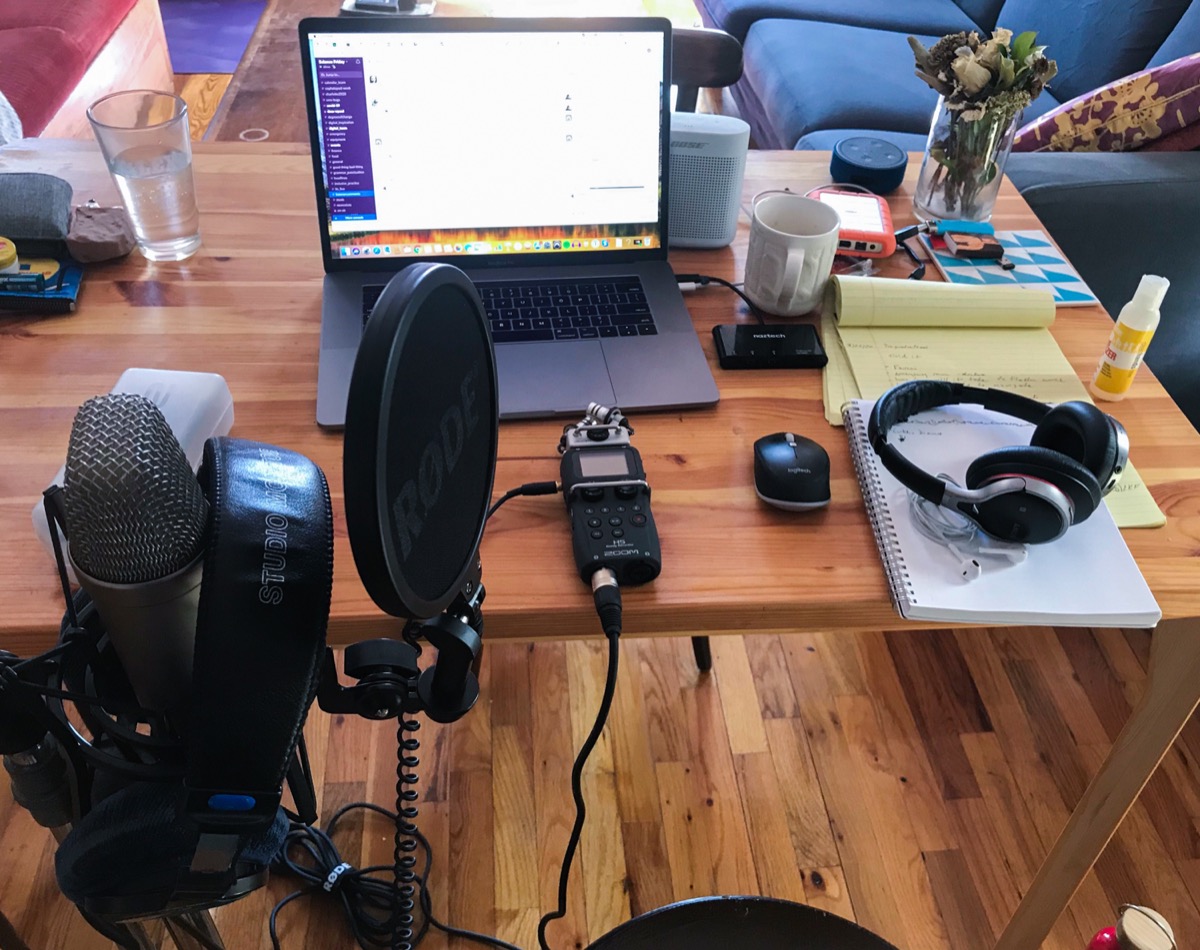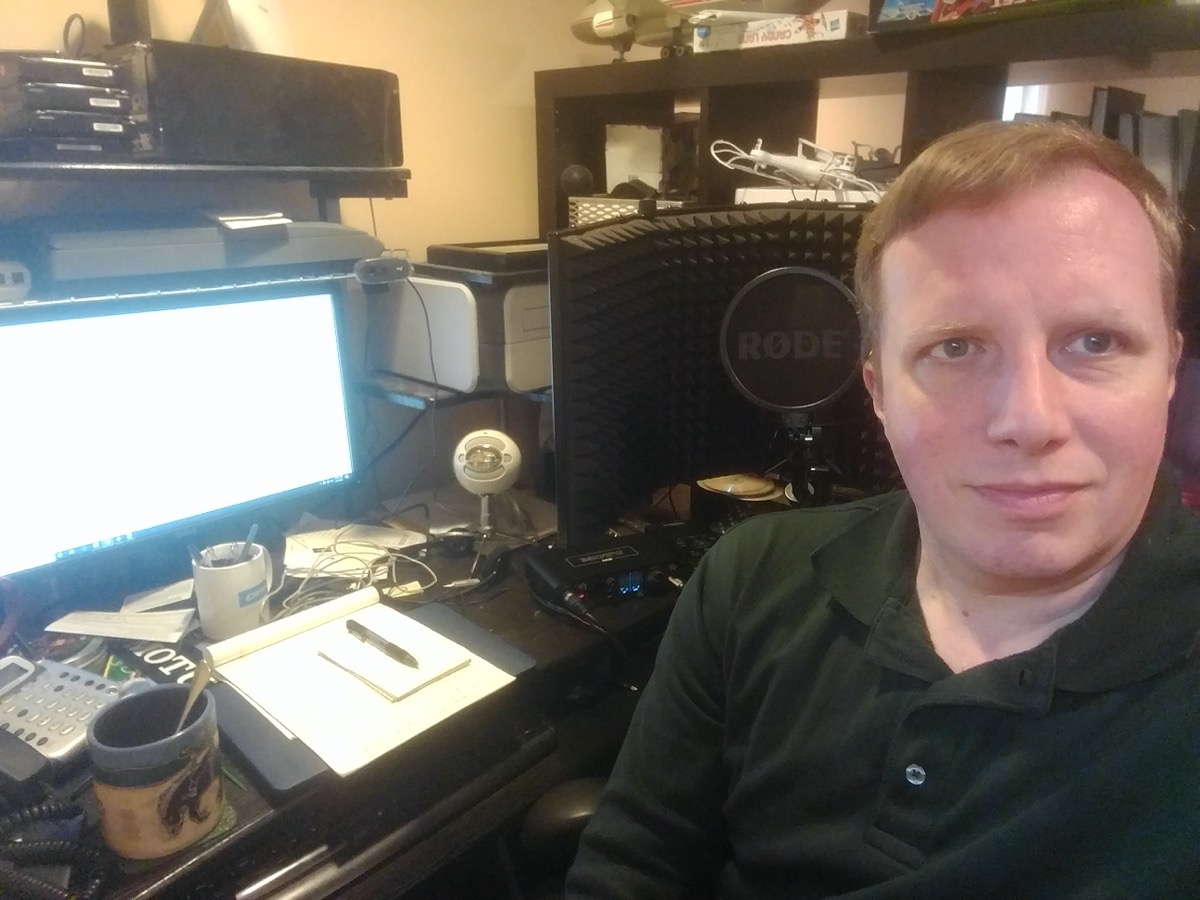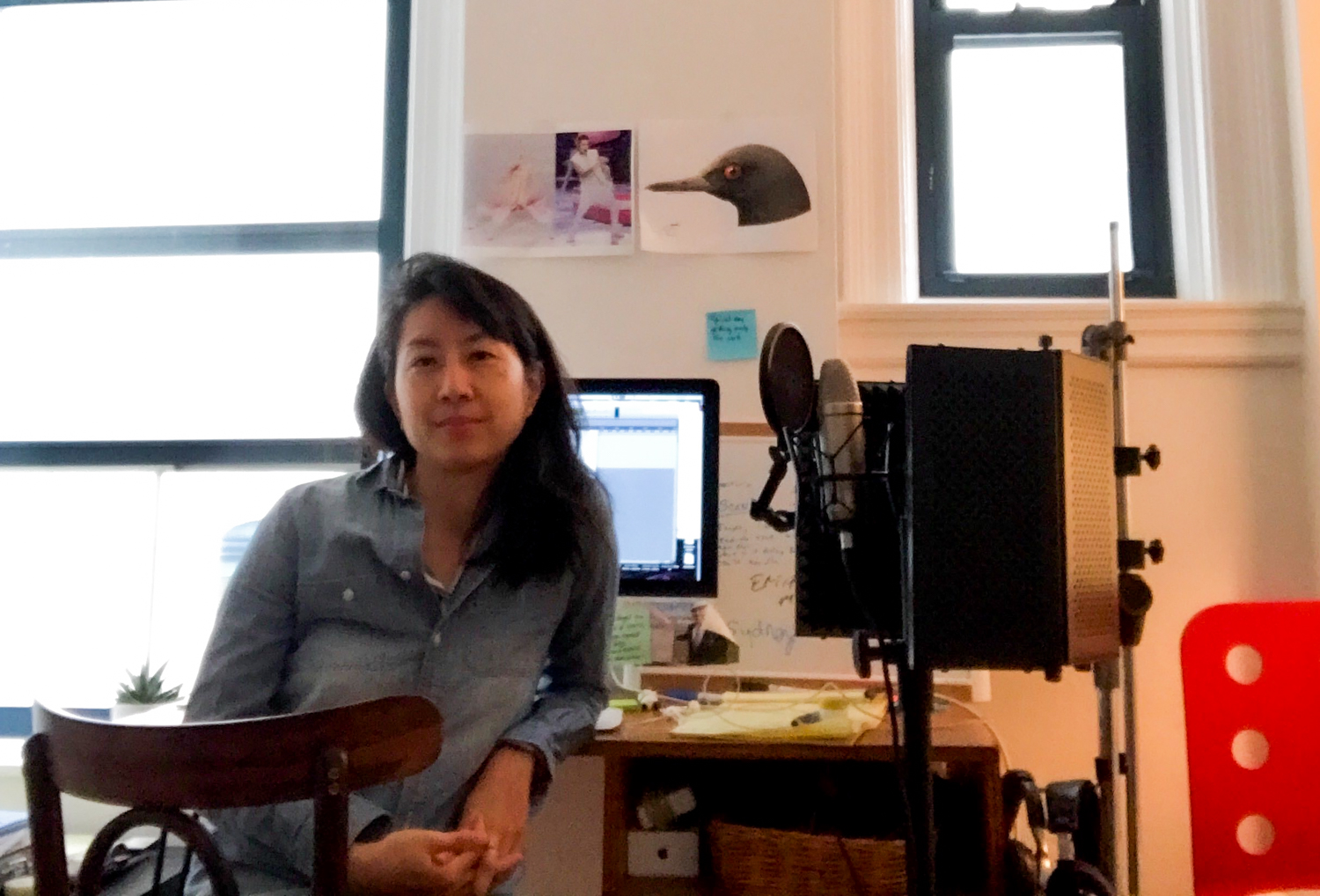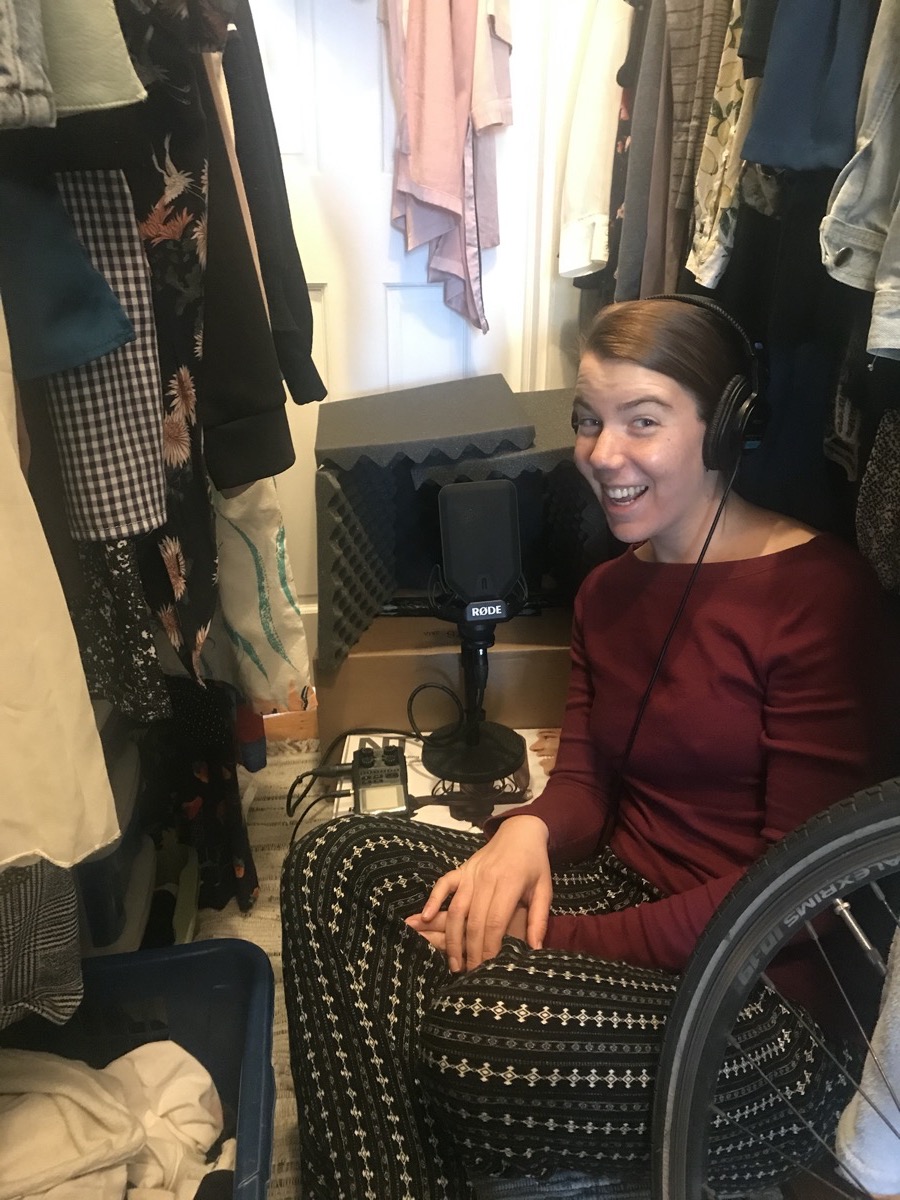How Science Friday Produces Radio, From Home
Science Friday producers share how the team has restructured a live radio show during the coronavirus pandemic.

This story is a part of Science Friday’s coverage on the novel coronavirus, the agent of the disease COVID-19. Listen to experts discuss the spread, outbreak response, and treatment.
For decades, Science Friday has thrived on the spontaneity of live broadcast. Off-the-script jokes with guests, emotional and insightful listener calls, and the thrill of orchestrating cues and interviews make live radio a joy to listen to and produce. But two months ago, we had to adapt alongside the rest of the world during the coronavirus pandemic.
On March 28, after our studio in New York City limited access for the safety of staff, Science Friday shifted from a live Friday broadcast to a fully pre-produced show.
As we’ve distanced ourselves from work, social activities, and schools to limit exposure to COVID-19, we’ve learned how to manage our time differently and make adjustments on the fly—and Science Friday is no exception here. All of the SciFri staff have transformed the way we work, including livestreaming events online, doing digital citizen science demos, onboarding new staff remotely, and creating a new radio production schedule.

Despite changes, the radio team took the “new normal” as an opportunity to experiment. Producers quickly pivoted from making a radio show together in a professional studio, to setting up recording booths remotely in their apartments. In addition to coordinating time zones and booking guests, they have to schedule interviews around lawn mowers, elevator maintenance, bird calls, and honking cars. Creating in-studio quality audio in a New York apartment is no easy feat (the show is often coming to you from closets, kitchens, basements, mics propped on air conditioners, and “soundproofed” blanket forts).
They’ve also had to act as both producers and hosts. While some have been on the show before, a few made their debut behind the mic! To continue to feature listener voices, producers have been creatively collecting your thoughts before the show through the SciFri VoxPop app and social media. This is all juggled during an expedited pitch and production cycle, with producers closely monitoring the latest COVID-19 news and studies.
There have been many learning curves along the way—and we expect more to come. But the team has never been more determined to deliver the science stories that matter to you.
Listen to SciFri producers and staff share their experiences below!
Invest in quality science journalism by making a donation to Science Friday.
“This is Nadja Oertelt. I joined Science Friday on February 11, 2020, which was only a few weeks before the world was turned upside down by COVID-19. And being here during this transitional moment has been really interesting. I’m Science Friday’s new chief content officer, so my role is to think about how all of the different interconnected pieces at Science Friday—our educational team, our radio team, our podcast team, our digital team, our events team—how they all fit together and how they create a coherent narrative out of scientific research and science news. It’s been very interesting trying to change everything all at once for our radio team, but also for all of our other teams and being at the center of that has been a challenge sometimes, but also really rewarding.
I think in moments of extreme flux you’re able to change things that might have been entrenched or might have been inflexible. But when everybody is forced to shift the way that they live and the way that they work, sometimes things that used to be entrenched actually become easily dislodged in a good way. I think a lot of the processes we have shifted over the past couple months have been really enlightening and really exciting. I’ve just been so impressed and excited by the work that all of our different teams have done and the amazing coverage and journalism and reporting that they have brought to the table.”

“I really never thought I’d be hosting interviews, but it’s been interesting. And this happened pretty early on in the process. It’s been a huge learning experience. I’ve been producing for Science Friday for seven years, but it’s really given me a new perspective on putting together segments. For Ira, he’s a pro, so you can toss him anything and he can handle it. For me, I have to plan things a bit more, take a little bit more time. It’s definitely fun and—definitely nerve-wracking—but I think we’re learning as we go, seeing what works and what doesn’t work and just improving each week.”
“This is Christie Taylor, I’m a radio producer for SciFri. I basically spend all of my time underground now. I share a two-level apartment with three other people and my snug basement bedroom is actually the quietest place for recording. The closet is bad—I checked that. When our neighbor runs the water, you can hear all of the pipes gurgling. I have to ask my roommates to avoid walking in the room above me, and even though the soundproofing is pretty good for a New York apartment, we still have to coordinate our meetings so that this incredibly sensitive microphone doesn’t pick up their voices when I’m recording a guest.
Even when I’m not at a live microphone, my ears have become very finely tuned to every creaking floorboard, chirping bird noise, and thump from the outside world. And I also have a picture of a praying mantis hanging above my microphone so I remember there is a real person that I’m talking to at the end of every interview. It sounds better if you smile.
But it’s also really, really exciting to be here. In one week in March, we completely flipped our process around from live to pre-recording and we’ve been tweaking that workflow ever since. It’s a lot of change and I’m really, really proud of what we’ve been able to accomplish. It’s also a lot more work. Now that we can have perfection in the on-air product, the only real limit on that is our time and energy, which depending on the week is both a blessing and a curse.”
Radio pro tip: put a face above your microphone so you remember to speak in the correct direction while recording interviews. pic.twitter.com/vtY0KQuSfY
— do I dare to tweet a screech? (@ctaylsaurus) April 1, 2020
“This is Kathleen Davis, I am one of the producers of Science Friday. So my situation is pretty different from the other producers because I actually started working at Science Friday in mid-March which was right around the time where the show was shifting to being pre-produced. So I had to start a brand new job completely remotely in this time of flux. Thankfully, I do have pre-production radio experience and hosting experience so it hasn’t been a bad transition, it’s just been really strange. But everyone has been so nice at Science Friday and checking in to make sure that I’m not overwhelmed and I’m doing okay. So overall, it’s been a fine experience.”

“This is Johanna Mayer. I host and produce the Science Diction podcast and I am talking to you from my closet, which is where I am spending a lot of time these days because this is where I record the show. It is perhaps not the most glamorous studio setup, but it does the trick. One plus about this whole situation is that I can record wearing sweatpants.
And we’re still collaborating. It just looks a little different. Under normal circumstances, development producer, and my editor, Elah Feder and I sit down together to have these roundtable edits to just really talk through stories and edit together. And when we record episodes, she sits in the recording booth with me. But now, thank goodness for video chats, because that’s where everything happens.
We have these marathon video calls for edit sessions and when we’re finally ready to record an episode I kind of balance my laptop on a stool in the closet next to me, so then I can talk to Elah on video while also recording and she can listen to how it sounds and give me notes. It actually works pretty smoothly. The only thing that I have to worry about is angling the camera so she can’t see my sweatpants.”
A special @scifri project about valley fever coming to you soon, from my closet and A/C mic stand 😁 pic.twitter.com/O7UGxaXFh0
— Lauren J. Young (@laurenjyoung617) April 11, 2020
“Hey, this is Lauren Young and I’m a Science Friday digital producer, and I’m talking to you from my closet. I recently produced my first ever audio story for Science Friday in April. When I had first pitched it, I would have never expected I’d be recording it from a mic propped on top of my air conditioner in the closet of my apartment. We had to work around my noisy heater and elevator construction in my apartment. I’ve just been so impressed by our how radio team has been bringing new science stories every Friday without fail.”
Invest in quality science journalism by making a donation to Science Friday.
Annie Nero is Science Friday’s individual giving manager. She enjoys listening to music through giant headphones.
Lauren J. Young was Science Friday’s digital producer. When she’s not shelving books as a library assistant, she’s adding to her impressive Pez dispenser collection.